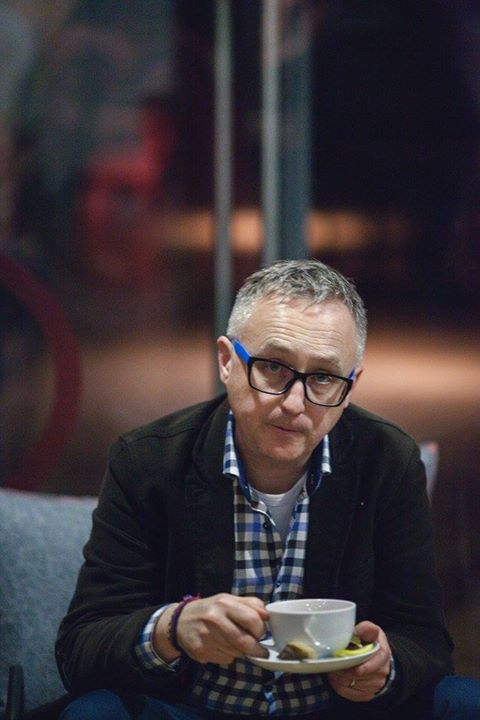Karol Radziszewski: Queer Archives Institute at Berlin’s Gay Museum
Karol Radziszewski: Queer Archives Institute, Schwules Museum, Berlin, June 20 – September 23, 2019
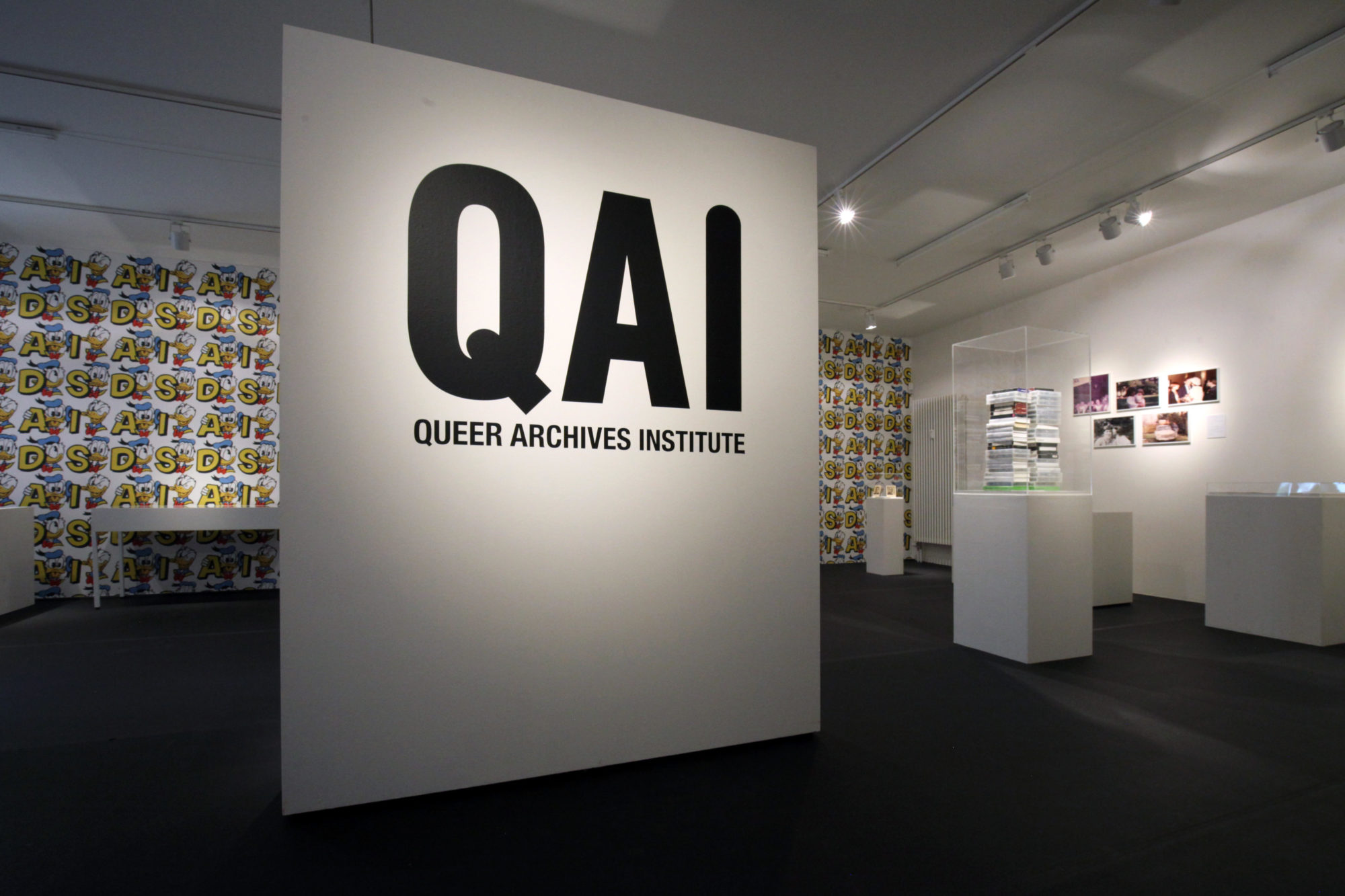
View of the QAI exhibition from the entrance of the gallery space. Photo by Dorothea Tuch.
From June 20 to September 23, 2019, Berlin’s Schwules Museum [Gay Museum] hosted an exhibition of queer archives from Eastern Europe collected and presented by Karol Radziszewski, Polish artist, activist, and founder of the Queer Archives Institute (QAI). The QAI is among the most extensive and most visible of a number of queer archives recently founded in Poland and in other Central and East European countries, where celebrating and memorializing non-heteronormative lives and cultural production remains a novelty, perhaps even a rarity. Historically, these countries differed in their approaches to same-sex activity and to transgender persons—for example, socialist-era Poland permitted same-sex acts and made transitioning easier than it does nowadays. However, even a liberal attitude of the law did not translate into public visibility, social acceptance, or specific rights geared toward sexual minorities. Across the region, LGBTQ activism was stifled, as were other civic institutions, until the end of the Cold War. After 1989, the discourses of lesbian and gay liberation, transgender rights, and queer activism and theorizing all arrived on the scene more or less simultaneously, compressing and thus complicating a narrative of progress as measured with access to rights, and confounding distinctions such as those between queer and gay.
In the particular context of Central and East Europe, Radziszewski’s use of the term “queer” arguably has a threefold meaning. First, it connotes social and cultural activity with some political significance. In the pre-1989 years and in the years immediately following the transition, the political goal of queer activism and art—then mostly synonymous with lesbian and gay activism and art—was to break out into the public realm in however minimal a way. Second, “queer” refers to the non-heteronormative past before the age of gay liberation, much as it does in Douglas Crimp’s formula, “queer before gay.” While a number of exhibits on display in Berlin dated from the late 1980s and 1990s, some went back to the 1960s and earlier; thus, referring to them as gay would be anachronistic and would risk confusing viewers. Third, Radziszewski himself considers the QAI collection to be open-ended, in that he continues to gather artifacts and in that he is interested in presenting these artifacts in ways that open up rather than close down the historical narrative. This entails the inclusion of an interview with a transgender activist, for example, as well as investigating what belongs to a queer archive and on what terms.
The exhibition at the Gay Museum presented items and records from the QAI collection, some drawings borrowed from a private owner, and Radziszewski’s own work, and it attempted to realign them along two main vectors. One concerned the distinction between private and public expression in Soviet-controlled and post-Soviet spaces in which speech was severely censored, pornography illegal, and gay or queer activism small in scale and stifled by the state like most kinds of civic activity. In retrieving queer material from the era, Radziszewski placed work that was originally meant for private consumption in the public context of the museum. This belated repositioning illuminated how private expression may have functioned as a (counter-) public statement already at the time of its articulation.

View of the gallery space with the video screenings of an interview with Romana Bautič and of Afterimages, and with Ryszard Kisiel’s photographs in the background. Photo by Dorothea Tuch.
The other kind of repositioning addressed the Ost-nostalgic, and thus implicitly marginalizing, perspective on queer archival traces of the state socialist period by insisting that they should be included in a global queer history as both a counter and a complement to its prevalently western, and often specifically US-focused, metanarrative.(Radziszewski’s exhibition was advertised on Berlin’s Gay Museum website as celebrating the 50thanniversary of the Stonewall Inn riots while bringing forth alternative perspectives on the queer past.) Ost-nostalgia was perhaps an inevitable side effect of the exhibition being staged in Berlin, especially since the Gay Museum is located only blocks away from the place where a concrete wall once literally divided the East from the West. Like the legendary East German Trabant, objects that used to be mass-produced in the Soviet bloc, photographs portraying socialist architecture with its magical neon lights, and the graphic design of early queer zines all evoke a sense of a bygone and exotic world. Radziszewski presented these aesthetic marvels without foregrounding their formal side, but he still used their unquestionable visual appeal to carve out a space for them within the broader territory of a common queer heritage that he is ceaselessly inviting us to imagine.
This double repositioning pertains not just to Radziszewski’s use of material but also to his own situatedness as a self-identifying gay man who is simultaneously an artist, an activist, and an archivist/collector, as well as someone who works in his native Poland but routinely presents his work abroad. Radziszewski examines and often bridges the divides between retracing the past and finding a fitting contemporary esthetic, between conducting research and being engaged, between witnessing and intervening, and between addressing local issues and making his work accessible to international audiences. The gesture of pointing out such paradoxes and suggesting ways in which they can be overcome informed the exhibits put on display in Berlin.
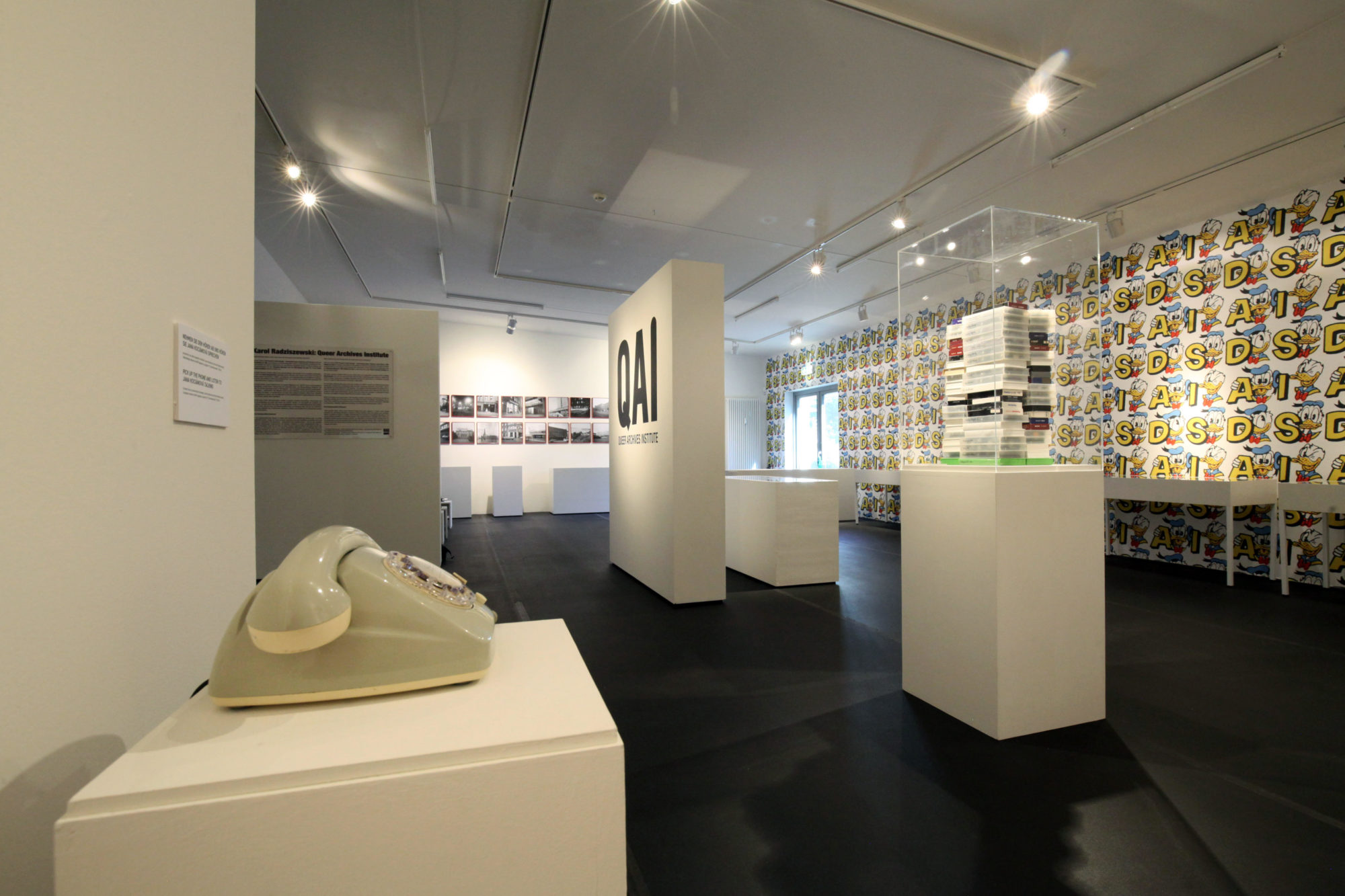
View of the exhibition, showing a rotary phone with the voice recording of Jana Kocianová (on the left) and a sculpture-like arrangement of 69 video cassettes with pirated commercial porn once owned by Krzysztof Jung (on the right). Photo by Dorothea Tuch.
Radziszewski’s long-standing collaboration with the early Polish gay activist Ryszard Kisiel was given special prominence in the exhibition. One gallery wall was covered with wallpaper designed by Radziszewski and based on Kisiel’s playful combination of the letters “AIDS” with images of Donald Duck that came from imported bubble gum wrappers popular in Poland in the 1970s and 1980s. Kisiel borrowed these playful images, which were seen as exotic at the time because they originated on the other side of the Iron Curtain, for a logotype he used in his samizdat gay zineFilo. Radziszewski added color and rearranged Kisiel’s logotype in the manner of General Idea’s AIDS (created just a year before Kisiel’s “AIDS”), a transformation subtly underscoring the parallel queer histories taking place on either side of the geopolitical barrier.

Karol Radziszewski’s AIDS wallpaper (2012) based on Ryszard Kisiel’s “AIDS” logotype in his zine Filo. Courtesy of Karol Radziszewski.
Against the backdrop of the wallpaper, Kisiel’s Filo was presented in vitrines alongside other queer magazines from Eastern Europe. Their rugged DIY appearance underscored that the gradual emergence of independent queer print culture in the former Soviet bloc defied official censorship. Dates of publication were telling, with the Czech, Slovenian and Polish preceding those from Belarus, which dated from the 1990s. Radziszewski’s own DIK Fagazine was also on display and issues devoted to Eastern Europe were available for perusal. A multifaceted historical narrative was suggested by this sequence of exhibits.
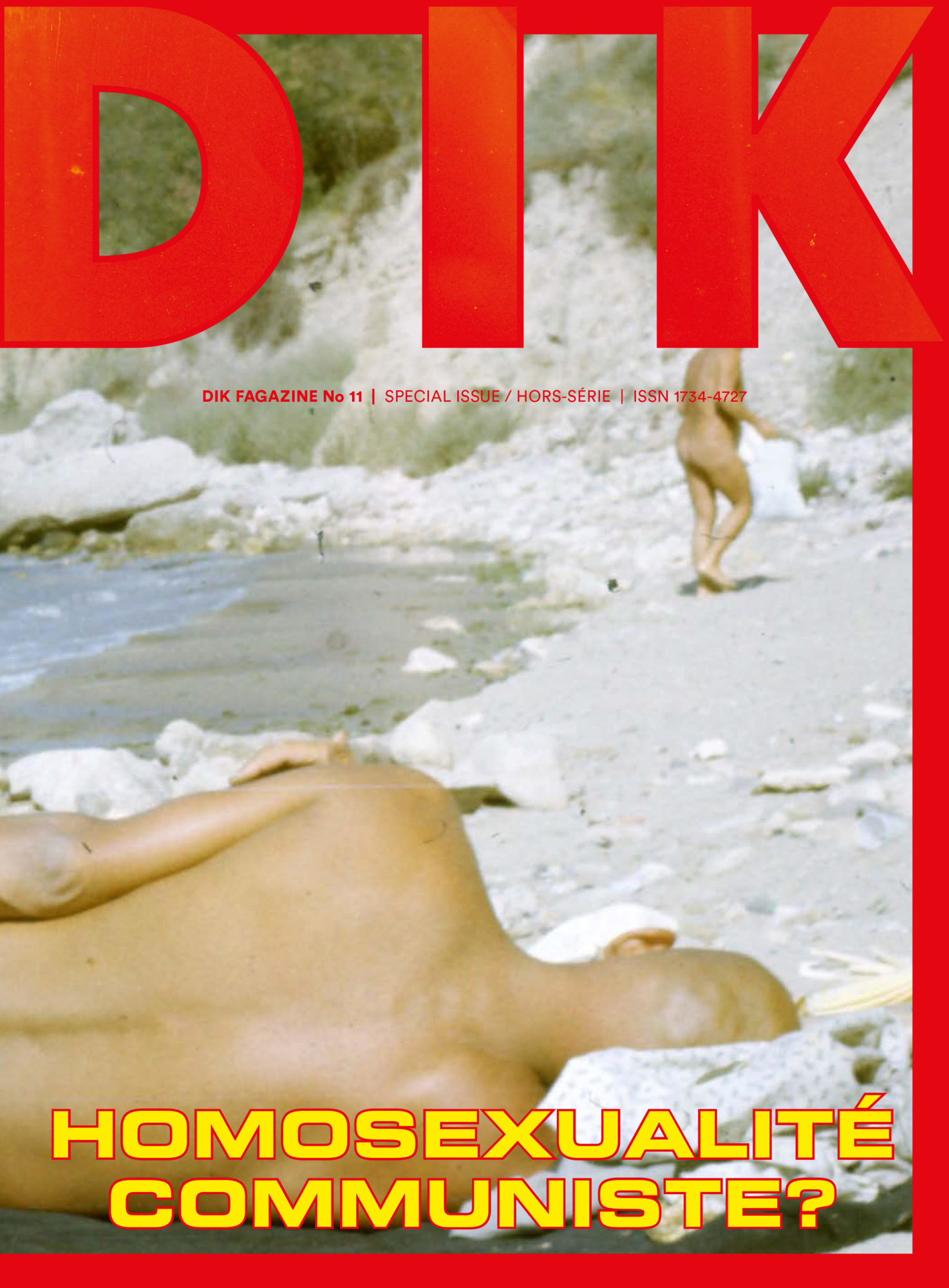
DIK Fagazine issue on “Communist Homosexuality?” (2017). Image courtesy of Karol Radziszewski.
Photographs used by the Hungarian filmmaker Mária Takács in her Secret Years (2009) poignantly underscored queer twists underneath the veneer of ordinary life under state socialism: in one, a lesbian couple is seen standing next to a socialist-era car, in another, a double wedding seems perfectly ‘straight’ except that the brides were lesbians and the grooms were gay men. Surprising, non-ostentatious interplay between the official and the unofficial was a recurring feature in many of the works on view. Like the car in the photo, some objects on display—no longer being in common use—invoked and played with viewers’ sense of nostalgia while others illustrated bygone esthetic standards. A rotary phone provided intimate access to a voice recording of the late Czech performer Jana Kocianová, whose conversation with Radziszewski was featured in DIK Fagazine. In the center of the room a pillar made up of sixty-nine VHS cassettes with pirated films, including both gay and straight porn and once the property of the late Polish artist Krzysztof Jung, commemorated his manner of watching and debating such films in communal settings at a time when both pornography and queer activism were banned. Erotic drawings by the Polish scenographer and painter Kazimierz Wiśniak, created in the 1960s in the context of a private exchange, invited a comparison with similar work from the era associated with western gay liberation.
A number of exhibits offered glimpses of essentially private activities that had a political meaning in the absence of overt organizing. A looped slide show presented snapshots of Kisiel with a couple of friends camping outrageously in drag or barely clothed, and with their body parts painted. Unlike regular photographic prints, these transparencies could not be developed in a makeshift darkroom at home, but had to be handled by a professional studio. Allowing the possibility that those intimate, if highly theatrical, pictures might be witnessed by strangers was Kisiel’s act of private defiance in the face of a crackdown on homosexual men in mid-1980s Poland. A display case contained items worn by the men in the photos, including plastic jewelry and lace. In the context of severe market shortages of the time, such ordinary objects indexed the material opulence, as well as the erotic possibilities available in the mythical first world. Whiffs of nostalgia thus flowed in both directions, as contemporary Ost-nostalgia met its predecessor, Eastern Europe’s nostalgia for the west.
A sampling of street-view photos that Kisiel took while traveling throughout Eastern Europe in the late 1970s and the 1980s documented his interest in spots frequented by homosexual men, such as bars, baths and cruising spots. His copious, hand-written notes list addresses, opening hours, prices charged for entry, and other information regarding a vast number of such locations.(Kisiel documented gay-interest spots in as many as twenty-four towns across Poland and traveled internationally, including to East Berlin.) The sheer immensity of the auto-ethnographic undertaking impressed; placed in a museum gallery, it seemed to attain the status of a conceptual project. Kisiel had his unique compendium bound and he gave it a printed English-language title page announcing the Polish Gay Guide on the Europeans Socialists Countries. The goal was to divert visitors’ attention away from the volume, which sat on a shelf at Kisiel’s home, rather than to advertise its content. The word “gay” was not yet common in Polish and almost no one could read the foreign-language title.
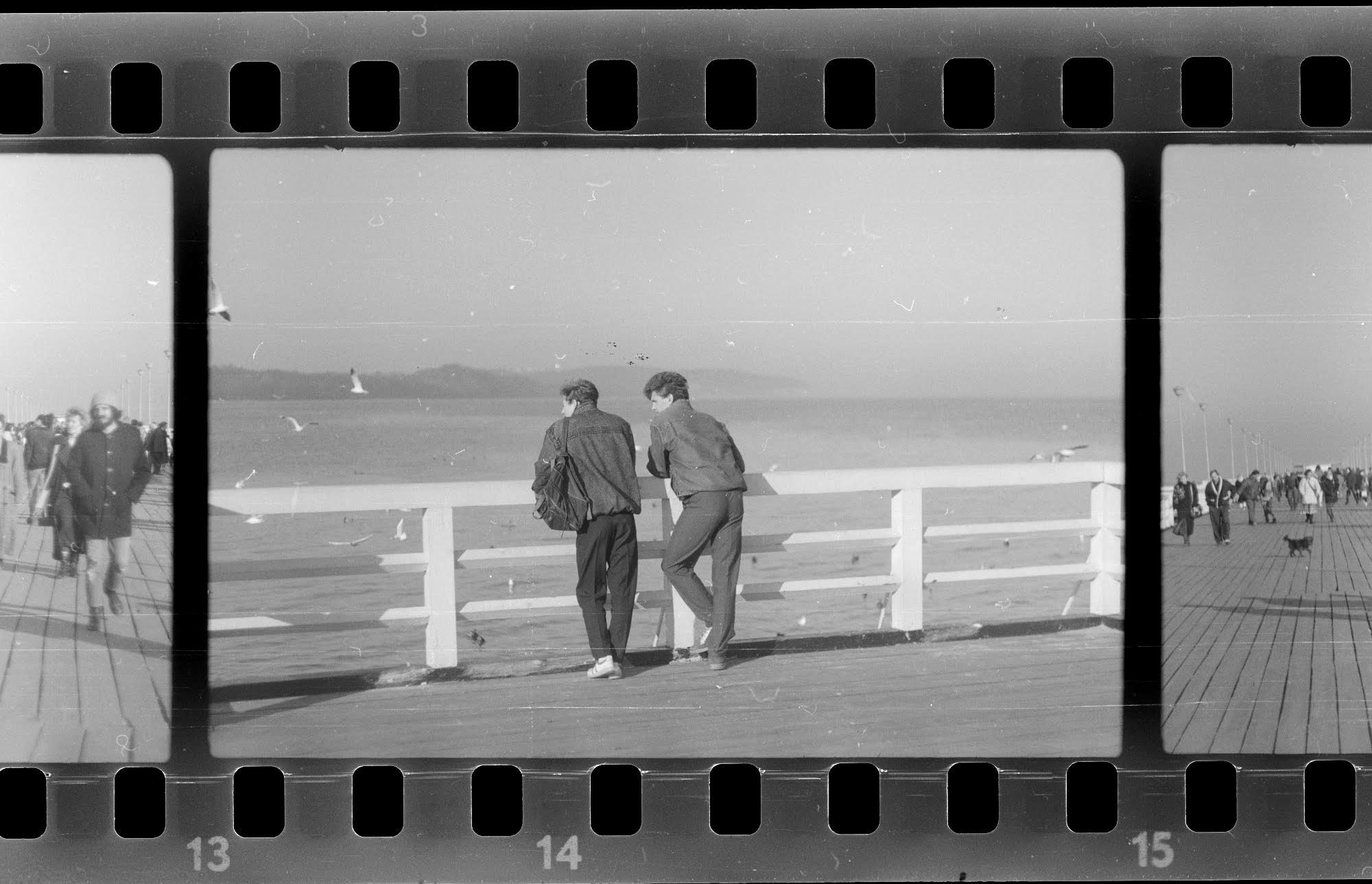
Frame from Afterimages (2018). Courtesy of Karol Radziszewski.
A video entitled Afterimages presented, frame by frame, a roll of film that Kisiel accidentally exposed twice, so that snapshots of places with gay interest taken in a Polish seaside town in the late 1980s became superimposed on previously executed images of gay male nudity and sex, inspired by a lost volume of Tom of Finland drawings. The video thus brought together Kisiel’s two-fold obsession with queering bodies and queering spaces. His running commentary was punctuated with a question from Radziszewski about Kisiel’s personal involvement in the pornographic session. The question implicitly pinpointed Radziszewski’s own complicated positionality as artist, activist and collector of archival traces.
Presented side by side with Afterimages was a video recording of the Croatian transgender activist Romana Bautič, who described her transition and her early media appearances. Her theatrical, tongue-in-cheek demeanor, including her apparent indifference about passing as a cis-gendered woman, matched Kisiel’s humor. The video provided a post-Yugoslav perspective on the region’s manifold queer past.
Two exhibits reached back to a time before the onset of the Cold War. Postcards with photographic portraits of the Polish writers Maria Rodziewiczówna (1863-1944) and Jan Lechoń (1899-1956) provided a counterpoint to the other exhibits. Both writers had same-sex partners, but they are hardly remembered for their queer attachments. Moreover, both were social conservatives. Their inclusion as somewhat unlikely precursors of contemporary queer culture illustrated the conceptual difficulty of creating and presenting a queer archive. Should we think of Rodziewiczówna as a lesbian woman and of Lechoń as a gay man? Should they be recognized as belonging to a queer past? And if so, what sense can be made of their conservative outlook? The physical isolation of these photographs, enclosed in a transparent case that made them seem like entomological specimens, posed these questions but ultimately left them unanswered.
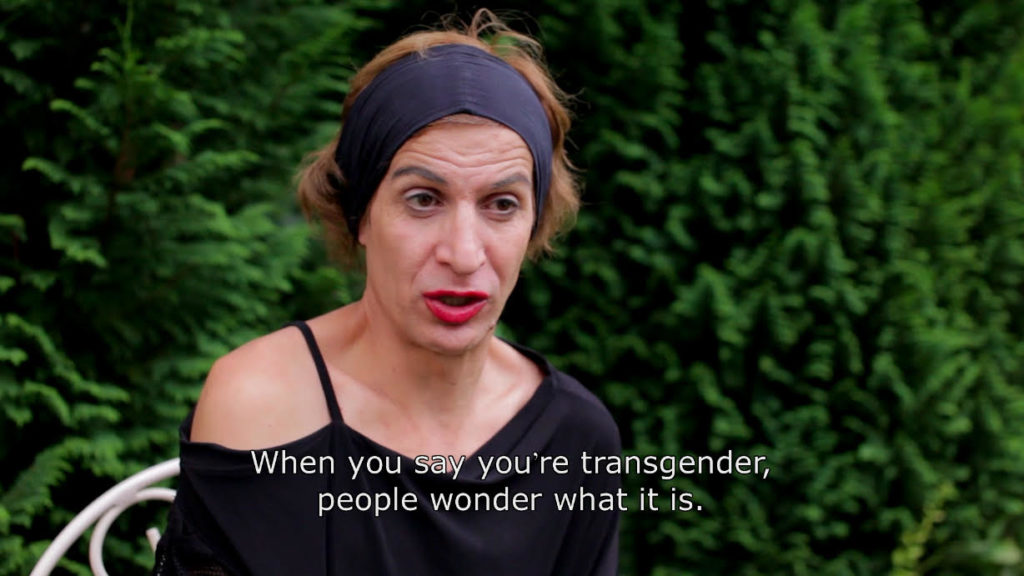
Frame from video interview with Romana Bautič (2016). Courtesy of Karol Radziszewski.
The Queer Archives Institute is an ongoing, open-ended project that exceeds the confines of a mere collection, thanks to Radziszewski’s skillful repositioning and transformation of archival traces. His interventions ranged from the wallpaper he designed out of Kisiel’s “AIDS”-and-Donald-Duck logotype, to the question he poses to Kisiel at the end of Afterimages,to paying tribute to Jung by salvaging his porn stack and giving it sculptural form. By repeatedly showing that the seemingly self-evident distinction between public speech and private expression is context-dependent, Radziszewski imbued the exhibits with both local and international significance, reinvigorating our sense of what counts as a queer past.
The exhibition Karol Radziszewski: Queer Archives Institute (curated by Ricardo Carmona) was presented at Berlin’s Gay Museum in cooperation with the HAU Hebbel am Ufer in the context of “The Present is Not Enough – Performing Queer Histories & Futures,” a festival which took place in June. Radziszewski and Kisiel were both guests of the festival.

